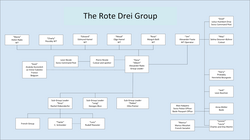| This article includes a list of general references, but it lacks sufficient corresponding inline citations. Please help to improve this article by introducing more precise citations. (April 2018) (Learn how and when to remove this message) |
The Red Three (German: Rote Drei) was the Switzerland section of the so-called Red Orchestra. It was established and maintained by Soviet Military Intelligence Staff Division 4.
Name history, and activities

The terms Red Three, and Red Orchestra respectively, were invented by the Reichssicherheitshauptamt (RSHA), the counter-espionage arm of the SS. As an essential part of the Red Orchestra, the Red Three (radio stations) (de: die Roten Drei (Funkstellen)) were outside the reach of German security forces, located in Switzerland. It was headed by Alexander Radó (code name: DORA), a Hungarian émigré, Communist, and geographer. The Red Three was founded in 1936, when Radó arrived in Geneva. By April 1942, the organization had been established with Radó as group leader, and also had three subgroup leaders: Rachel Dübendorfer (code name: SISSY), Georges Blun (code name: LONG), and Otto Pünter (code name: PAKBO).
After the imprisonment of Leopold Trepper (code name: GRAND CHEF) by the Gestapo in 1942, Radó's group became the most effective part of the Red Orchestra espionage network. It collected useful information in Switzerland and had some contacts inside Germany. Perhaps most importantly, Radó was also in touch with the Lucy spy ring, which had very valuable contacts inside Germany, and was linked to British intelligence. Some people have speculated that the Lucy ring was used by British intelligence to pass Ultra information to Soviet intelligence without revealing the codebreaking operation that was its source, but most historians do not agree with this theory.
In 1944–1945, Radó was recalled to the USSR and charged with spying for Britain and the U.S. He was imprisoned for eight years, but was released and rehabilitated after Stalin's death.
Roessler's sources in World War II
| This section is empty. You can help by adding to it. (November 2023) |
Bibliography
- Mulligan, Timothy P. (April 1987). "Spies, Ciphers and 'Zitadelle': Intelligence and the Battle of Kursk, 1943". Journal of Contemporary History. 22 (2). Sage Publications, Inc: 235–260. doi:10.1177/002200948702200203. JSTOR 260932. S2CID 162709461.
See also
- Lucy spy ring
- Red Orchestra (espionage)
- Plötzensee Prison
- Schwarze Kapelle
- White Rose
- FRG 1972 (TV Miniseries),
References
- Tittenhofer, Mark A. (4 August 2011). "The Rote Drei: Getting Behind the 'Lucy' Myth". CIA Library. Center for the Study of Intelligence. Archived from the original on March 27, 2010. Retrieved 4 January 2019.
- "The Lucy Spy Ring". spymuseum.com. Archived from the original on 2017-12-01. Retrieved 2018-02-17.
- Trepper, Leopold (1977). The Great Game McGraw–Hill, Inc. ISBN 0-07-065146-9
- Brysac, Shareen Blair (2000) Resisting Hitler: Mildred Harnack and the Red Orchestra Oxford University Press. ISBN 0-19-513269-6
External links
- Plötzensee Memorial Centre Archived 2019-08-31 at the Wayback Machine
- BFCentral
- on Sophia Poznanska
- Book review of Red Orchestra by Anne Nelson. Random House website. Retrieved April 7, 2010
- L'orchestre rouge at IMDb
| People of the Soviet Rote Drei espionage group | |
|---|---|
| Rote Drei group |
|